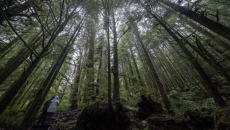OTTAWA - Seven months after Canada and Germany agreed to build a new hydrogen supply chain across the Atlantic Ocean, the 2025 target date for the first shipments is on track, Natural Resources Minister Jonathan Wilkinson says.
"There's been a lot of activity," he said in a recent interview.
"I am hopeful that certainly by the end of the year we will be in a position where we can actually say that there are projects that are actively moving ahead."
He expects final investment decisions by the fall on at least two of four projects being contemplated in Nova Scotia and Newfoundland and Labrador.
The EverWind Fuels hydrogen project in Point Tupper, N.S., received its first environmental permits from the province in February and has started clearing sites and doing engineering work.
CEO Trent Vichie said in an interview Monday all signs point to bringing the US$1 billion first phase to fruition by 2025, producing 220,000 tonnes of ammonia annually. Phase 2, with another US$5-billion investment, will increase production to one million tonnes and add an onshore wind farm by the end of 2026.
"We're working like crazy," said Vichie.
Because ammonia is easier to transport, most low-emission hydrogen projects are looking to make that, with the recipient in Europe converting it back to hydrogen on the other end.
Europe is looking to massively expand its use of hydrogen to reduce reliance on fossil fuels and meet its climate change targets. It is also looking to wean itself off reliance on Russian oil and gas, after Russia began using energy as political leverage during its invasion of Ukraine.
Last week the European Union agreed to increase its goals for renewable energy to make up 42.5 per cent of its energy supplies by 2030, up from 22 per cent. That improves market demand for green hydrogen, said John Risley, a director at the World Energy GH2 hydrogen project proposed for the west coast of Newfoundland.
Risley said Eastern Canada is well placed for shipment to Europe, and between government support and growing demand, the industry is looking better every hour.
"Every day that goes by there is less risk," he said.
GH2's project, Nujio'qonik, the Mi'kmaq name for St. George's Bay where it is located, seeks to eventually produce 250,000 tonnes of hydrogen using power from three new wind farms.
It is currently awaiting an environmental review from the province and is engaged in some wind measurement studies and community outreach.
EverWind signed non-binding agreements with two big German energy companies in August, the same day Canada and Germany signed their own hydrogen pact. Vichie said turning those agreements into actual contracts is the next hurdle, and they had been waiting for the federal budget to see exactly what the government will be offering to help.
The answer is a lot. A new 40 per cent investment tax credit for capital funding of low-emission hydrogen is expected to cost almost $18 billion over the next 12 years. The budget also confirmed the new Canada Growth Fund can offer contracts for difference — basically a financial guarantee to investors that they'll get a certain price for their hydrogen or the fund will make up the difference.
"It was a really strong sign of how important the sector is, against what was touted as sort of a tougher-time budget," Vichie said.
Risley said the investments will keep Canada competitive with the United States, which made significant hydrogen investments in the Inflation Reduction Act last year.
Wilkinson spent last week at a hydrogen conference in Berlin along with several Canadian hydrogen company executives, where the need for contracts for difference was clear.
"Right at present, they don't have a clear definition on some of the demand issues and perhaps of the pricing of hydrogen or ammonia," Wilkinson said.
Risley said for now it's still cheaper to make grey or black hydrogen — the kind extracted from fossil fuels but which carries a big carbon footprint. The International Energy Agency said in 2021 99 per cent of global hydrogen production was grey or black.
The green hydrogen EverWind and GH2 are pushing uses renewable power like wind or solar, to split hydrogen out of water molecules using electrolysis. Green hydrogen has no emissions but costs more to make, prompting the need for government investments to spur production.
Eventually those costs will come down and the government help will be less necessary.
"If you can buy grey hydrogen for $1 and green for $1.25 you're going to be reluctant to pay more," Risley said.
Hydrogen is mainly used to help in oil refineries and to make fertilizer, iron and steel, and methanol, an alcohol used in some paints and plastics and construction materials.
In the low-carbon economy transition, hydrogen can play a bigger role as a source of energy to power cars, heavy vehicles, planes and cargo ships, and to replace coal and natural gas as a source of electricity.
Typically one kilogram of hydrogen can power a car to travel about 100 km, or generate enough electricity for three average homes for a year.
Canada is also hoping to export "blue" hydrogen, which is made from natural gas but uses carbon capture and storage systems to contain greenhouse gas emissions and trap them underground.
Europe is less keen on blue hydrogen, but Wilkinson said part of the negotiations in Berlin last week included a new plan to agree on emissions standards, as well as to do more on the trade route itself.
Vichie said there are some European ports capable of accepting ammonia shipments but more are needed. Germany is looking to build an ammonia terminal in Hamburg but not until 2026, a year after Canada wants to start shipping.






